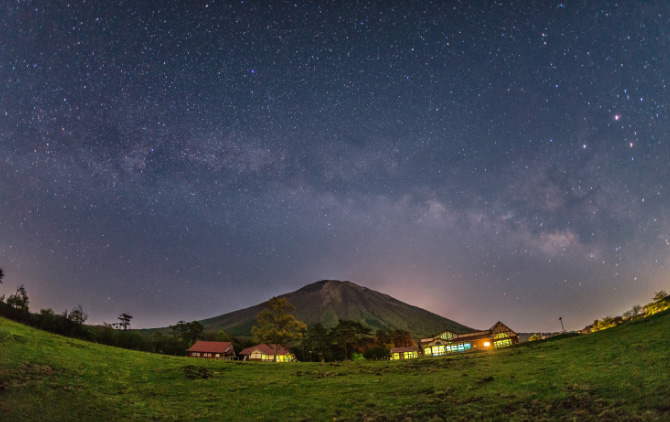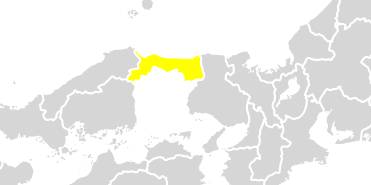Healing the mind and body with Shimane’s hot springs and shrines
Beginning and ending at Fukuoka, this journey takes you along the northern coast of Shimane prefecture to indulge in its famous hot spring resorts as well as castle towns with their well-preserved samurai districts. Explore Japan’s oldest shrine and enjoy some delectable local seafood specialties along the way.

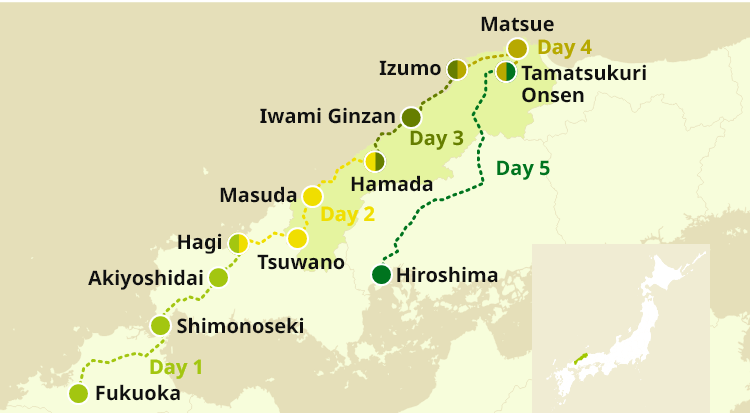
What to expect
- Hot springs famous for beautifying skin
- Edo-era castle towns
- Izumo Taisha, Japan’s oldest shrine
Fast facts
- Duration: 5 days
- Distance: Around 700 kilometres
- Transport: Car
- Discover Another Japan Pass: ATTRACTIONS PASS 5-DAY

Get unlimited admission to major tourist attractions in the region. Discover Another Japan Pass is applicable wherever you see this icon.
-
Day1
-
Day2
-
Day3
-
Day4
-
Day5
Fukuoka Airport
about 90 mins by car

Shimonoseki
Shimonoseki is a vibrant port city in a strategic location along the Kanmon Straits, and connected to Kyushu via the Kanmon Bridge. Surrounded by water on three sides, Shimonoseki is famous for its seafood, specifically fugu (pufferfish), which can be sampled at the bustling Karato Market. Other attractions in town include the Kaikyokan Aquarium, the Kaikyo Yume Tower, and the gorgeous European-style buildings from the Meiji Era lined along the waterfront – evidence of Shimonoseki’s role as a major trading hub.
-
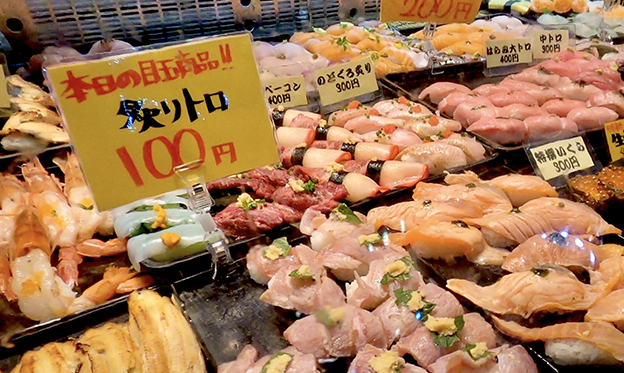
Karato Market
The lively Karato Market is where you can witness auctioneers hawking all kinds of seafood, especially fugu, which is caught here in abundance. You can interact with the friendly vendors or head upstairs to the cafeteria to savour some reasonably-priced sushi or seafood bowls.
https://www.japan.travel/en/spot/174/Read More
-
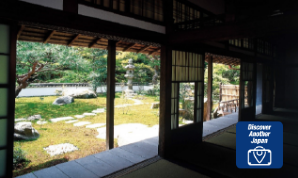
Chofu Mori-tei
This is a samurai residence built by Mototoshi Mori, the 14th head of the Mori family in Chofu. It was also used as the temporary residence of Emperor Meiji. The stately main building and the pure Japanese style garden surrounded by white walls are reminiscent of the past.
Read More
about 60 mins by car

Akiyoshidai
Located near Mine City, Akiyoshidai is the largest karst plateau in Japan, characterised by rolling grasslands dotted with limestone formations. This magnificent landscape began as a coral reef over 300 million years ago, and was pushed upwards over the years. Winding trails run through this rocky grassland plateau, making for a picturesque walk. Every February, a controlled burning of the area known as “Akiyoshidai Yama-yaki" is conducted, where locals set fire to the grasses to prepare the land for new sprouts.
https://www.japan.travel/en/spot/1979/-
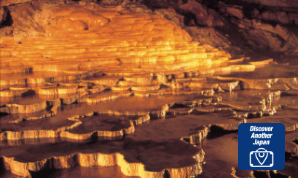
Akiyoshido Cave
Akiyoshido Cave is one of Japan’s largest limestone caves, stretching about 100 metres below the ground. The constant temperature of 17º Celsius throughout the year makes it a comfortable place to visit all-season. The wide variety of mysterious natural formations that seem to have been frozen in time is sure to evoke great amazement.
Official websiteRead More
-
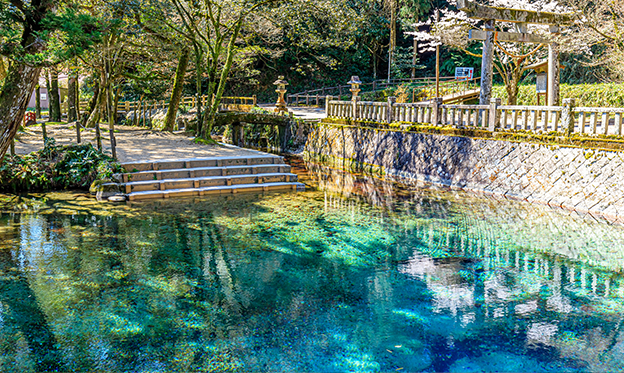
Beppubenten Pond
The 4m-deep Beppubenten Pond is known for its incredibly clear, blue water which is also channelled to a nearby trout farm. There are restaurants around the farm where you can savour trout, or catch your own fish and have it cooked for you.
Read More
about 50 mins by car

Hagi Hot Spring Village
Boasting 8 different hot spring areas populated with countless hotels and bathhouses, Hagi once prospered in the 17th century as a castle town and still retains its old townscape today. Explore Hagi Castle’s ruins and well-preserved streets lined with historic samurai and merchant houses, and ancient sites relating to the Meiji Restoration. End the day with a soothing soak at Hagi Kanko Hotel; set on a hill overlooking the sea, it’s a classic hot spring hotel with rooms and outdoor baths accentuated by gorgeous views of Hagi port.
about 60 mins by car

Tsuwano
Known as “Little Kyoto of the San-in Region,” Tsuwano is a castle town dotted with historic buildings housing sake breweries, art galleries, and craft stores. Home to the important Taikodani Inari Shrine, it is also the embarkation point of the SL Yamaguchi, a steam locomotive that chugs through the unspoiled countryside. Ride a chairlift up the hill to the ruins of Tsuwano Castle and enjoy a bird’s eye view of the entire town.
https://sanin-japan.com/featured/tonomachi-

Tonomachi Street
The Tonomachi district is a well-preserved block of the former samurai district, characterised by white plaster walls and red roof tiles of former samurai homes. The main path here is lined with a moat that is filled with lively swimming koi carps and blooming irises (in season).
Read More
-

Taikodani Inari Shrine
Established in the 18th century to protect Tsuwano feudal domain from disaster and famine, Taikodani Inari Shrine is built on a castle ruin, accessible via a long series of stairs lined with a dense number of vermilion torii gates. It takes about 15 minutes to climb through this mysterious torii tunnel.
Read More
-

Hori Teien (Hori Garden)
Hori Garden is the residence and garden of the Hori family who have made their mark in history as a wealthy family of copper miners for several generations. The garden has been designated as a National Place of Scenic Beauty and is also famous for its alluring autumn foliage.
Read More
about 50 mins by car

Masuda
Manpukuji Temple
This is a family temple of the Masuda clan, the lords of Masuda Nanao Castle, and is famous for its stone garden created by the Master Artist Sesshu, which has been designated as a National Historic Site. You will also find the Shinji-ike, a pond designed in the shape of the Japanese character for ’heart’.
about 50 mins by car

Hamada
Located along the coast of the Sea of Japan, Hamada has many fine, white sand beaches with interesting coastal geology. Like many towns along this coast, Hamada is a former castle town with its castle ruins located on a hill. Hamada is also home to Aquas, a large aquarium famous for its performing Beluga whales. As a major port town, it is a centre for excellent seafood – Hamada City is particularly famous for its nodoguro (black-throated sea perch).
-

Iwami Kagura Performance (SanKuu Shrine)
Iwami Kagura is a traditional performing art in western Shimane. The fusion between the original Kagura, a dignified Shinto ritual, and Iwami's dynamic dance hold audiences spellbound. Gorgeous costumes and masks are all hand made by locals.
Read More
-
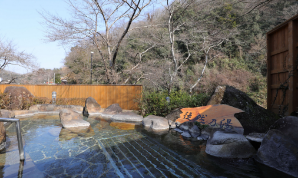
Mimata Hot Spring
Shimane Prefecture is famous for its many hot spring areas promoting beautiful skin like Mimata Onsen. Located in a picturesque mountainous area, this hot spring is over 150 years old and its alkaline water has a reputation for making skin moist and smooth.
Read More
about 60 mins by car

Iwami Ginzan Silver Mine
Iwami Silvermine Museum
The Iwami Ginzan Silver Mine thrived from the 16th to 18th century and used to produce almost one-third of the world’s silver. It has been designated as a UNESCO World Heritage site largely due to it having co-existed with nature. Take a walk through the ruins or head over to the Iwami Silvermine Museum to check out the tools and materials concerning the mines.
https://sanin-japan.com/featured/iwami-ginzanabout 60 mins by car

Izumo
Izumo is home to its crowning attraction: the namesake Izumo Taisha, one of Japan’s oldest and most sacred Shinto shrines. Savour some locally-made wariko soba which is served in three tiers of lacquerware, and learn about ancient Japanese mythology by watching a sacred kagura dance performance dedicated to the Shinto gods. Explore the Shimane Museum of Ancient Izumo, or visit Izumo’s other ancient worship sites like Hinomisaki Shrine and Gakuenji Temple, which is famous for its waterfall.
-

Izumo Taisha Grand Shrine
Surrounded by sacred trees, Izumo Taisha enshrines Okuninushi no Okami, a deity of “en musubi” or good relationships. During prayers, visitors clap their hands four times instead of the usual two times. A striking feature of the grand shrine is its shimenawa, a huge straw rope hanging in the front.
https://sanin-japan.com/featured/izumotaishaRead More
-

Shinmon Avenue
The main approach to Izumo Taisha is Shinmon Avenue, a road lined with countless snack stores, restaurants, and traditional inns. Bookended by two giant torii gates, a staple snack on this street is zenzai, a sweet red bean soup with glutinous rice balls, said to have originated here.
Read More
-

Izumo Zenzai Mochi
Try Izumo’s specialty, a handmade zenzai-mochi which is a baked soft rice cake wrapped around sweet bean paste. It also makes the perfect souvenir to take home from Izumo Taisha.
Read More
-

NIPPONIA Izumo Taisha Monzen-machi Hotel
NIPPONIA Izumo Taisha is a boutique hotel that combines history with modern comfort. At this renovated historical Japanese home, the rooms have been meticulously restored to preserve the original architecture. Guests are served French cuisine made with local ingredients, paired with local sake.
Read More
about 60 mins by car

Matsue
Known as a “water city,” Matsue is a castle town crossed with many canals and is attractively located along the shores of Lake Shinji, Lake Nakaumi, and the Sea of Japan. The city is essentially divided by the Ohashi River, with the northern section dominated by Matsue Castle and its samurai district, while the southern section is dotted with many ancient shrines and temples.
-

Adachi Museum of Art

The Adachi Museum of Art houses nearly 2,000 modern Japanese paintings including a great collection of paintings by Yokoyama Taikan. The Japanese gardens at the museum have been ranked number one for 19 consecutive years by the Journal of Japanese Gardening.
Official websiteRead More
-

Matsue Castle
Matsue castle is one of only 12 remaining original castles nationwide and was designated as a national treasure in July 2015. The watchtower on the top floor offers a lovely panoramic view of Matsue city and Lake Shinji.
https://sanin-japan.com/featured/matsue-castleRead More
-

Matsue Horikawa Pleasure boat (Fureai Square)
The inner and outer moats around Matsue castle are virtually unchanged from when it was built about 400 years ago. Circle these moats and pass under 17 bridges on a 50-minute boat tour. In the winter, Kotatsu heaters are placed in the boat to provide a comforting warmth.
Official websiteRead More
-

Shinjiko Sunset Cafe
Shinjiko Sunset Cafe is only open on sunny days from 4pm on weekends and 5pm on weekdays, and closes after sundown, catering to spectators of the sunset over Lake Shinji. Located on the banks of the lake, this tiny take-out cafe’s specialties include a special blend of coffee and a soda that resembles the colours of sunset.
Read More
about 20 mins by car

Tamatsukuri Onsen
Dating back to the 8th century, Tamatsukuri Onsen is one of Japan’s oldest hot spring areas, with resorts lining the Tamayu River in the centre of town and its waters famous for beautifying skin. The town is founded on the production of jewel-shaped magatama agate beads which are thought to hold spiritual powers. Many visitors also come here to wish for romantic luck at various spots around town, or stroll along the picturesque tree-lined riverbank.
-

Yuyakushi Hiroba
Head down to the riverside and enjoy a free foot bath at designated areas along the river. At Yuyakushi Hiroba, fill a water bottle with hot spring water and take it home with you, or purchase some skincare items made with hot spring water.
Read More
-
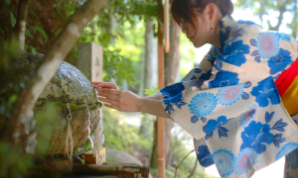
Tamatsukuriyu Shrine
The ancient Tamatsukuriyu Shrine is well-known as a spiritual spot, with a wishing stone said to fulfil your wishes if you touch it and pray. The red bridge which leads to the temple grounds is also a popular photo-taking place.
Read More
about 3 hours by car

Hiroshima
Hiroshima is known for its WWII history – explore the city’s war-era sites like the Peace Park and Atomic Bomb Dome via a retro streetcar, or visit its cultural sites like Shukkeien’s Japanese gardens and the majestic Hiroshima Castle. Make a short excursion to nearby Miyajima, which is home to the world-famous Itsukushima Shrine and its “floating” torii gate in Hiroshima Bay. Food lovers will not want to miss Hiroshima’s famous okonomiyaki pancakes and oysters.
-

Shukkeien Garden
Shukkeien is a 400-year-old Japanese garden of Hiroshima domain’s feudal lord from the Edo Period. It is renowned for its miniature landscapes of Japan’s mountains, valleys and forests. The garden retains its tranquility while being centrally located in Hiroshima City.
https://www.japan.travel/en/spot/889/Read More
-

Hiroshima Oysters
Hiroshima is Japan’s biggest oyster producer and plenty of oyster rafts dot the waters around the bay. The oysters have small shells, with plump flesh and a rich taste. The best time to enjoy oysters is winter, when they are popularly served freshly-grilled at charming oyster huts.
Read More
-

Itsukushima Shrine
The 12th century Itsukushima shrine is famous for its unique design of being built over water. The beautiful contrast of colours between the blue sea, vermilion shrine and green virgin forest behind makes it a popular tourist spot. The shrine complex is also listed as a UNESCO World Heritage Site.
Read More
-

Miyajima Misen Daisho-in
This prestigious temple is over 700 years old and has the longest history in all of Miyajima; even the famous Hideyoshi (feudal lord and chief Imperial minister; 1585-98) has held a tea ceremony here. Try your hand at copying Buddhist scriptures and tracing Buddhist images.
Official websiteRead More
You have the option to return your car at Hiroshima Station and head back to Fukuoka via the shinkansen (the ride takes 2 hours), or continue on your journey by car (around 280km). On the return section, you can explore some interesting spots along the Seto Inland Sea.
Get advisory information regarding COVID-19 situation in Japan
Go to Advisory Information website


